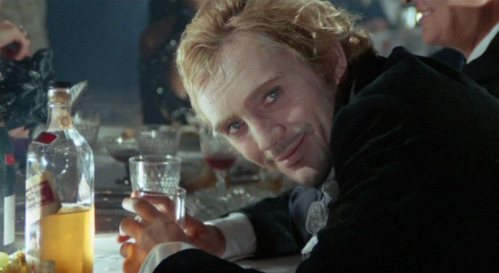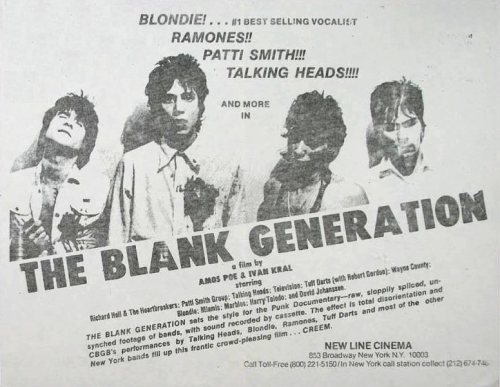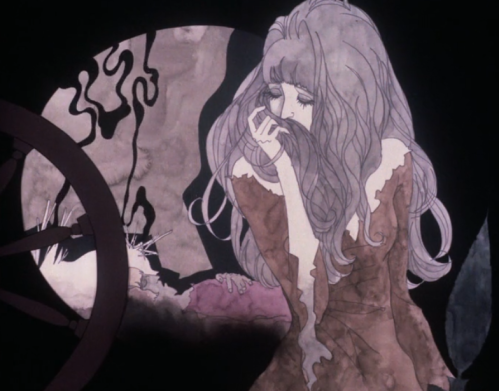
The arrival of a vampiric looking English actor in Rome’s Fiumicino Airport is greeted with paparazzi furiously snapping his picture, their flashbulbs blinding him momentarily. Incandescent with rage, he hurls a suitcase at one, hitting and knocking him to the ground.
The actor is Toby Dammit, a stressed-out and booze-sodden mess, unravelling at an alarming rate.
At the top of an escalator, he sees a vision of a pre-teen girl (Marina Yaru) who looks like she might just have stepped off the set of a much more recent J-Horror chiller. Her skin is every bit as pale as his own and her hair is similarly fair. She says nothing but bounces a white ball.
This is a strikingly strange start to any film but things only get more bizarre as events unfold.

Toby Dammit – now there’s a name I doubt you’ll find in your local phone directory – is played by Terence Stamp, in one of his finest performances. The film is the third segment of an omnibus movie Spirits of the Dead (or in Italian Tre passi nel delirio).
The idea of the work was to have three pieces all related by being based on the stories of Edgar Allan Poe. Originally Orson Welles, Joseph Losey and Luchino Visconti were envisaged to helm the film but in the end Fedirico Fellini, Louis Malle and Roger Vadim did so.
Fellini has been a fan of the American author since childhood, and he considered a couple of stories – The Tell-Tale Heart and Premature Burial – before deciding to adapt the 1841 short story Never Bet the Devil Your Head: A Tale With a Moral. And when I say adapt, I mean adapt in the loosest sense. He updated things to contemporary Italy and reputedly didn’t even read the story before making his film.
It’s not a universally loved collection but Fellini’s entry has picked up a whole lot of praise over the years. It’s easy to see why.

Dammit is in Italy to star in the first ‘Catholic Western’ which seems to be telling the story of a cowboy Christ, its title being Thirty Dollars, which is maybe partly a reference to thirty pieces of silver as well as spaghetti western titles A Fistful of Dollars and For a Few Dollars More. Clint Eastwood incidentally was one of a number of actors considered to play Dammit. I can’t see that having worked.
Thirty Dollars is said to be ‘something between Dreyer and Pasolini, with just a hint of John Ford’ a priest acting as a producer tells Toby. He shows no interest in hearing the details. But he is keen to ask about a promised Ferrari sports car.
His career is on the slide, presumably due to his large intake of drink and he likely sees this as a final payday.
He’s whisked off without warning to a TV studio and grilled on a live talk show with rapidfire questions from a variety of hosts. ‘Do you take LSD or other drugs?’
‘Always.’
He’s asked if he believes in God. He doesn’t. He’s asked if he believes in the Devil.
He does.

Next up on his itinerary is a glitzy cinema awards ceremony. People tout themselves and family to him hoping he can help their career in some way, though he can’t help himself. There’s a fashion show interlude with models decked out in futuristic space-age fashions that actually scream 1960s.
Award winners deliver the same short acceptance speech. His stand-in enters the venue on horseback. The actor swigs whisky from his oversize hipflask before taking to the stage to recite some lines from Macbeth. This is followed by a very public breakdown.
Toby storms outside and is finally given the keys to the Ferrari. He puts his foot on the accelerator and speeds off irresponsibly with no fixed destination in mind.
On the streets, he sees mannequins of people and knocks one down. His journey must stop temporarily when he reaches a stretch of road before a collapsed bridge. A man in a mask tells him he must take a detour.
I don’t think I’m giving too much away by mentioning that he will once more see the girl with the white ball.

Fellini had been seriously ill in the lead up to shooting Toby Dammit. He feared death after being diagnosed with cancer of the pleura but recovered.
From the arrival of Dammit in an airport bathed in an unnatural orange-yellow light until the highly memorable and macabre image that ends the film, Toby Dammit is a disorienting watch. Only 37 minutes long, it resembles some extraordinary, surreal fever dream.
Here’s the trailer for Spirits of the Dead.











































